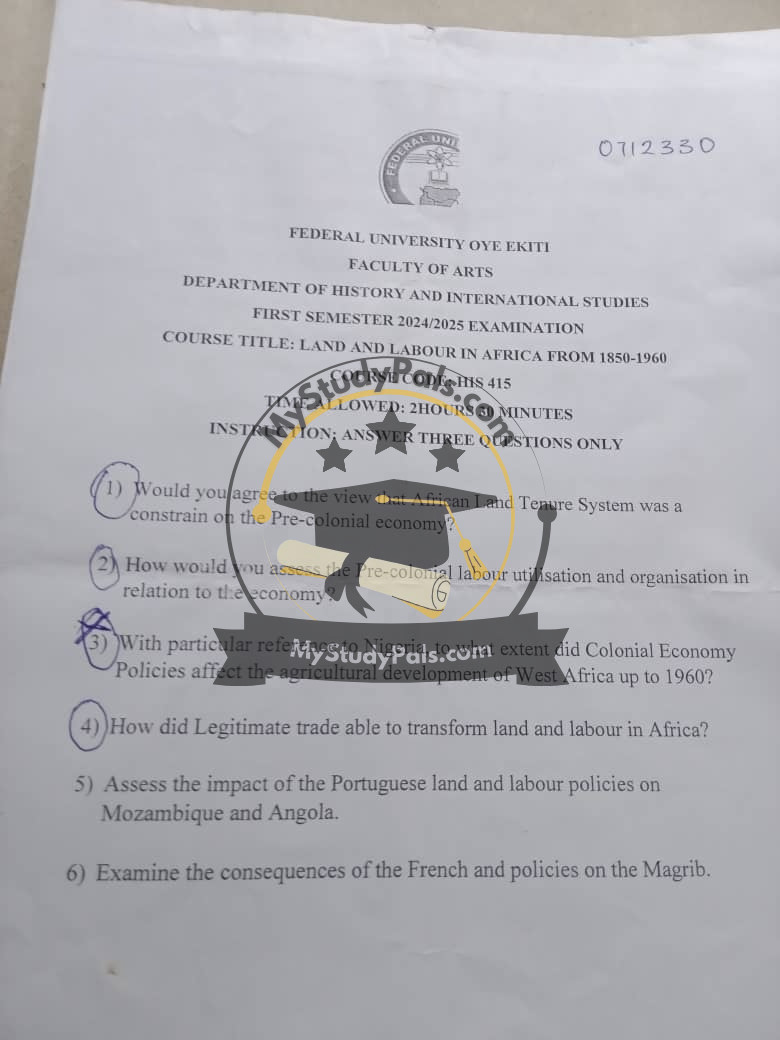ANWSER
Question 1:
The African Land Tenure System played a crucial role in the pre-colonial economy by regulating land ownership and usage. The system was predominantly communal, where land was owned collectively by families, clans, or communities, and individuals only had user rights. While this ensured equitable land distribution and discouraged land speculation, it also limited individual ownership and investment in land development. Some argue that this system constrained economic growth by discouraging large-scale agricultural production and private land investments. However, others view it as a sustainable and inclusive model that preserved social harmony and economic stability.
Question 2:
Pre-colonial labor utilization and organization were shaped by subsistence agriculture, trade, and craft industries. Labor was primarily communal, with family units providing the workforce for farming and other economic activities. There were also specialized labor systems, such as guilds for artisans and trade-based labor for merchants. The introduction of slavery and servitude, especially through the trans-Saharan and trans-Atlantic trades, significantly altered labor dynamics. While the system provided economic stability, it was also limited in scope, restricting large-scale industrialization and modernization before colonial rule.
Question 3:
Colonial economy policies in Nigeria and West Africa significantly affected agricultural development. The colonial administration prioritized cash crops such as cocoa, groundnuts, and palm oil for export, neglecting food crop production. Policies like taxation and forced labor compelled local farmers to grow export crops rather than staple foods. Additionally, land alienation and the introduction of European plantation systems disrupted indigenous agricultural structures. While these policies boosted the colonial economy, they created long-term challenges such as food insecurity and dependence on imported goods.
Question 4:
Legitimate trade, which emerged after the abolition of the transatlantic slave trade, transformed land and labor in Africa by shifting economic activities toward the production and export of goods like palm oil, cocoa, and rubber. This shift led to increased agricultural commercialization, the rise of African merchant classes, and the expansion of cash crop farming. However, the focus on export crops often came at the expense of food production, and colonial powers leveraged trade policies to exploit African labor and resources for European benefit.
Question 5:
The Portuguese land and labor policies in Mozambique and Angola were characterized by forced labor, land dispossession, and plantation economies. The colonial government established large-scale plantations and forced African populations to work under harsh conditions. The “contract labor” system was a form of disguised slavery, where Africans were compelled to work on farms and infrastructure projects for little or no pay. These policies led to widespread displacement, economic dependency on European markets, and long-term socio-economic challenges that persisted after independence.
Question 6:
French colonial policies in the Maghreb (North Africa) had significant consequences on land and labor. The French implemented land expropriation policies that transferred fertile lands from indigenous populations to European settlers, leading to widespread dispossession. The introduction of modern agricultural techniques benefited colonial settlers but marginalized local farmers. Labor policies forced many North Africans into low-wage jobs in agriculture and industry, both in their home countries and in France. These policies contributed to social unrest, resistance movements, and the eventual struggle for independence.


